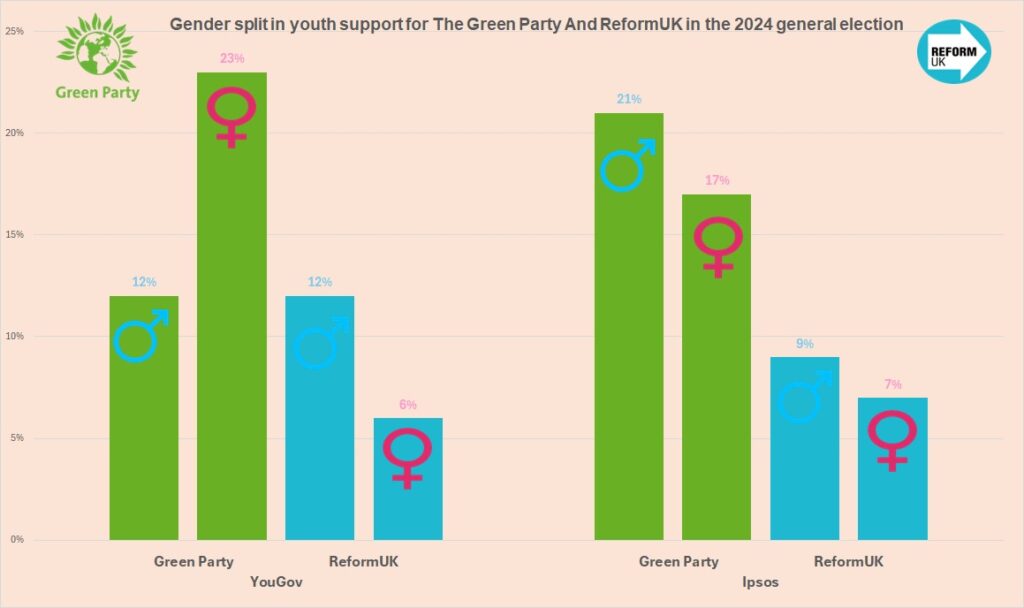As Britain’s young women drift steadily to the left, away from their male contemporaries, Gen-Z is becoming increasingly politically divided. But what is this all about, and why is this happening?
Gender divides are not unique to Gen Z, but they are growing
Gender has long had an impact on voting behaviour in Britain. What has changed in recent years however is just what impact this is, especially among Britain’s youngest voter generation, Gen Z.
For much of the 20th century, from around 1945 onwards, women have tended to be more right-leaning in their voting behaviour. The National Centre for Social Research has put down to women’s greater commitment to religion and lower exposure to institutions associated with the left, such as trade unions.
However, since the late 2000s this voting trend has reversed, with women becoming more left-leaning than men.
The National Centre for Social Research has described this phenomenon as the “modern gender gap”, which has seen women of younger generations (those born after 1960) become increasingly economically left-wing and socially liberal compared to men of their generation.
In recent years, this gender-based divide has become particularly pronounced among Gen Z.
According to the 2025 UK Youth Poll, conducted by the John Smith Centre, 20 per cent of young women declared their political allegiance as “Left”, compared to just 13 per cent of men.
In contrast, 26 per cent of young men declared their political allegiance as “Right”, compared to just 15 per cent of young women.
Evidence of a gender-based political divide among Gen Z is strongest when it comes to views on feminism.
According to a 2024 study conducted by King’s College London, “young men are notably less positive than young women about the impact of feminism”.
Among 16-29 year olds, just 36 per cent of men compared to 46 per cent of women surveyed agreed that feminism had done more good than harm.
In contrast, 16 per cent of young men said that feminism had done more harm than good, compared to just 9 per cent of young women.
The 2024 election
A gender-based political divide among Gen Z was also made clear in the 2024 UK general election, at least according to YouGov data.
While similar numbers of 18-24 year old men and women voted for Labour – 40 per cent of men, and 42 per cent of women, there were stark differences in support for the left-wing Green party and right-wing Reform UK.
Young women were just over twice as likely to vote for the Greens than young men, at 23 per cent compared to just 12 per cent of young men.
In direct contrast, young men were twice as likely to vote for Reform than young women, at 12 per cent compared to 6 per cent.
This data has been used by many outlets, including the BBC and TLDR News to highlight Britain’s growing gender divide.
However, when it comes to making these claims about the 2024 election, a note of caution is needed.
While the YouGov data shows a clear female preference for the Greens and male preference for Reform, election data from Ipsos tells a rather different story.
According to the Ipsos data, among 18-24 year olds it was in fact men that showed a greater preference for the left-wing Greens, with 21 per cent of young men supporting the party, compared to 17 per cent of young women.
Ipsos also showed a much greater similarity in support for Reform among Gen Z men and women, at 9 per cent of young men compared to 7 per cent of young women.

So yes, while there is evidence of a divide, variations in data mean that some caution is needed.
Why is this happening?
Why this Gen Z gender shift has happened is unclear, and contested.
One explanation advocated by some including John Burn-Murdoch of the Financial Times, argues that the change among Gen Z is due to the #MeToo movement, and rise of feminism among young women, which has prompted women to move to the left, leaving young men behind and frustrated.
Burn-Murdoch has also highlighted the impact of social media, and our increasingly siloed media culture, that has meant that “young men and women now increasingly inhabit separate spaces and experience separate cultures”, meaning that “Gen Z is two generations, not one”.
Another explanation is more purely economic, arguing that as women have been more negatively affected by economic policies such as austerity since 2010, they are more likely to oppose it, and therefore support left-wing parties.
According to an LSE blog post, in the 2015 and 2017 elections it was young women’s economic pessimism that contributed to greater support for Labour, as “younger women were particularly anti-austerity”.
This economic pessimism has only continued in more recent years, as according to Ipsos data, in 2023 it was women aged 18-34 that were most pessimistic of all groups about the state of the UK economy, with a net economic optimism rate of -57, 18 points lower than the net economic optimism of men of their age group.
Final Thought
It is worth noting however, as pointed out by the John Smith Centre, that evidence of this political divide are based on the relatively small percentages of young people at the left and right-wing extremes of politics, and that the vast majority of Gen Z are centrists and broadly agree with each other – “men’s and women’s views do differ, but on many issues they are more alike than not”.
And, as seen in the differences between the YouGov and Ipsos data regarding the 2024 election, it is hard to get a definite measure of the political opinions of all of Gen Z, particularly as political opinions can be unstable, and liable to change.
Gender is just one factor among many that influences a person’s political opinions and voting behaviour, and can’t be used as a definitive measure of whether one will be left or right wing.
With data as unreliable and variable as this, it’s very difficult to make a definitive judgement.
With that being said, there is evidence of splintering political views, if at least on the issue of feminism, showing that on some subjects, and between some young people, a gender-based political divide that has emerged in Britain.
Where this will go in the future, and the impact it will have on future elections, is yet to be seen.
Featured image via View Apart / Shutterstock.




